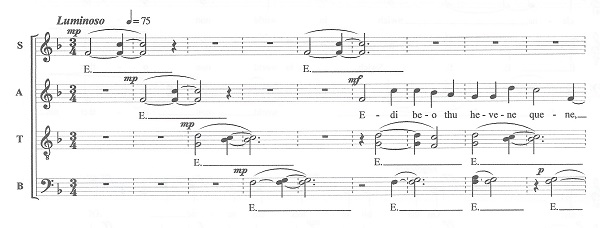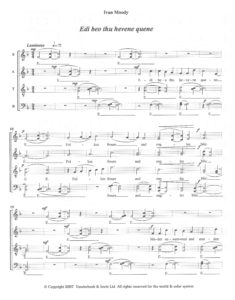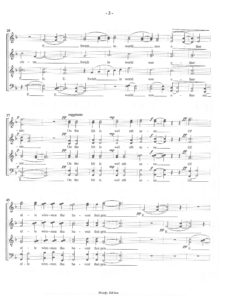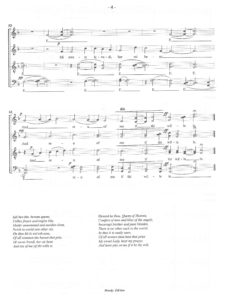Harmonic and Melodic Practice in English Vocal Music from the Time of Dunstaple to the Present Day
By Graham Lack
Benjamin Britten
Benjamin Britten (1913-1976) occupies such a central place in British music of the 20th century that one could write a book about just his choral music. Some have (see Kenneth G. Boos: The Study of the Relationship between Text and Music in Five Selected Choral Works of Benjamin Britten, DMA, University of Miami, 1986). Britten’s reputation is an international one and was secured, as many commentators have noted, with the premiere of his opera Peter Grimes at Sadler’s Wells in June 1945. While his music remains rooted in earlier English traditions (he issued a book of British folk-song arrangements the same year), it faced-up to continental influences early on. The immediate reception of Britten’s music abroad was even stronger than Elgar’s and gained a more enduring acceptance. For the first time, Britain had produced a composer who was to cultivate assiduously a musical language that was internationally acceptable and with which other audiences could easily identify. Britten’s affinity with an earlier British composer, Henry Purcell – whom we brusquely ignored as we skipped three centuries’ music history, above, – is significant, too. Britten shared an eclectic disposition and prepared a new edition of this great British songsmith along with Peter Pears, explaining his editorial procedures in his essay ‘On realising the continuo in Purcell’s songs’ (in Henry Purcell: Essays on his Music, ed. Imogen Holst, OUP, 1959).
To return to Britten’s preoccupation with indigenous folk-song, and the ‘countenance’ of English music, let us examine the years 1939-1942, the period of his American exile. Here he first turned his attention to folk-songs of the British Isles, producing arrangements for tenor voice and piano later published as the first volume of six. Vaughan Williams before him had treated such folk sources with an unfitting reverence that results in nostalgic musical landscapes. But Britten goes well beyond mere arrangements, each song being completely re-worked. Of note are ‘The Salley Gardens’ and the famous ‘O Waly, Waly’. The purely English tunes remain unscathed, but take on a distinctly contemporary guise. Britten’s compositional technique allows him to risk more, and his bolder harmonic style points up a heady undertow of violence more subtly masked in the originals. The piano part displays such original voicing that ‘simple’ triadic structures are rendered wholly foreign.
In his vocal and choral music too, Britten uses these ‘islands of tonality’ – familiar tonic triads understood as part of the language of music as it had evolved over the centuries. His unique harmonic vocabulary is unmistakable and is unquestionably of our time. A triad in his hands remains rooted but original: a pure major tonality as evoked by Britten sounds like no other composer’s. Britten’s music is “tonal but evasive”, as Mervyn Cooke cogently puts it in The Cambridge Companion to Benjamin Britten (CUP, 1999). In a self-enclosed movement like ‘Villes’, which appears right after the fanfare that opens Les Illuminations, the solo voice is given a ‘tune’ that is but arpeggios of a major chord.
The author is aware of the familiarity of Britten’s choral works to many IFCM choral directors, works such as Hymn to Saint Cecilia, A Ceremony of Carols, Rejoice in the Lamb, A Hymn to the Virgin and the Missa Brevis, and would like to make a plea for a work probably less on these conductors’ radar: AMDG (Ad majorem Dei gloriam, ‘To the greater glory of God’), which dates from 1939, the year he arrived in the United States, This was the onset of a richly creative period, but for reasons that were not entirely clear at the time, he abandoned the piece. (US Customs, it turns out, prohibited Britten from bringing home several MSS, possibly believing them to be a secret code, and until 1976, AMDG was kept in the family of Dr. William Mayer, the composer’s American hosts. Upon Britten’s death various works, including the cycle in question, passed to the British Museum.) It was only published in 1989. A recent advocate of this highly demanding choral work is Michael Marcades, whose doctoral dissertation (Texas Tech University School of Music, May, 1999) was on AMDG.
The songs in AMDG were written for one-on-one a cappella vocal soloists and make prodigious interpretative demands on performers in terms of tessitura, timbre, and textual fidelity. If one were to catalogue all the choral devices invented by Britten, then AMDG might be the result. The poems by Gerard Manley Hopkins are as recondite as ever, the poet taking as his title the motto of the Jesuit order he joined as a young man. These texts are rhetorical flights of fancy but spoke immediately to Britten. In ‘God’s Grandeur’ the compositional response is a veritable cascade of harmony; in ‘Rosa mystica’ the mood is unremitting; as for the feelings of guilt inculcated by ‘O Deus, ego amo te’, Britten melds words and music into a breathtaking recitative; finally, ‘Heaven-haven’ offers a serenity absent up to now, and a moment of necessary spiritual repose.
To take but one short example of the harmonic style of AMDG: in the second movement, ‘Rosa mystica’, a pedal on the note ‘a’ exhibits initial strong rhythmic implications before emerging as an ostinato. Above and beneath this ‘a’, Britten delineates elemental major triads and chords of the seventh. Here he harks back to early fauxbourdon style on which Dunstaple drew, with its parallel motion in the upper voices, but Britten retains here the modernist mood. Any ensemble attempting the cycle is certainly called on first to ‘hear out’ the complex harmonic implications.
Contemporary British Music
Enough contemporary composers exist to justify a separate article. We shall single out just two: Nicholas Maw (1935-2009) and Giles Swayne (*1946).
Nicholas Maw was a Romantic composer who embraced modernism and realised that it was still possible to explore a new tonal palette within a ‘traditional’ musical language. Musical Europe of the 1950s resembled a battleground on which progressive and conservative parties propagated and protected their various ideologies. Maw enriched the language of Boulez with a romanticism only to be found in Richard Strauss before him, long after the factions had fallen silent. Works such as Three Hymns, to texts by 17th century poets, and a miniature gem, One foot in Eden still, I stand, which sets a poem by Edwin Muir, belie at times the composer’s serial roots, but remain avowedly lyrical. “Music has to be able to sing”, as Maw said often. Like Britten, his harmony exploits tonal tension in an original way.
Choral works by Giles Swayne rely on fragmentary vocal writing, but even at points of greatest dissonance, where harmonic relations between inner voice parts are the tensest possible, he strives for a pan-consonant style. Here we glimpse the long line of composers from Dunstaple by way of Tallis and Byrd, to Britten, and hence to these contemporary composers. Swayne never aligned himself with the avant-garde, nor with minimalism. Many larger pieces are worth examining, including the plangent threnody The Silent Land and a vigorous setting of The Tiger; but there are shorter works too, such as Magnificat I and Missa Tiburtina, both of which have remained popular, at least in Britain. Certainly, from the mid- to late 20th century onwards, the face of British music remained firmly turned towards Europe.
On the Distaff Side: British Women Composers of the 20th and 21st Centuries
Art represents the face of any society, and readers might be surprised to learn just how many women composers led successful careers in Britain during the 20th and 21st centuries. On this ‘sceptered isle’, the old boys’ network was penetrated by many on the distaff side. To name just some: Elizabeth Poston (1905-1987), Elisabeth Lutyens (1906-1983), Elizabeth Maconchy (1907-1994), Thea Musgrave (1928), Nicola LaFanu (*1947) Judith Weir (*1954) and Rebecca Saunders (*1967).
During the 1990s academia gradually opened itself up to new disciplines such as Gender Studies and Feminine Studies, and it was not long before Historical and Systematic Musicology reflected these changes. And if this movement within conservatoires and universities was at the time a mite radical for some people’s liking, it soon shed this purely oppositional role, thus rendering itself less open to verbal slights aimed at establishing just what colour the music should be.
In Germany there is currently much less openness to the country’s own women in music, perhaps because the German marketplace is dominated by Russian composers like Galina Ustvolskaya (1919-2006), Sofia Gubaidulina (*1931), the Romanians Violeta Dinescu (*1953) and Adriana Hölszky (*1953). But Rebecca Saunders is making her way. Melanie Unseld, a specialist for Gender Studies and Professor for the Cultural History of Music at the Carl von Ossietzky University Oldenburg, believes that many European institutions are still living in the 19th century, and it will take some time before composition will really be regarded as a woman’s job, as is the case, happily enough, in many Eastern Asiatic musical cultures.
But to return to the thread of the ‘contenance angloise’, let us look at Elizabeth Poston’s Jesus Christ the Apple Tree. Her simple setting of a mystical poem, by an unknown New England author (from Divine Hymns or Spiritual Songs by Joshua Smith, 1784) might be known to some but not to all. Cast in the ‘home key’ of music, C Major, Poston composes a carol without resort to a single accidental. The result would pass for a folk-song, and that is exactly what it is.
For choral directors who do not yet know Judith Weir’s Two Human Hymns (1995), they are full of melodic invention within a cannily restricted harmonic field. These settings for six-part choir and organ of two poems by the 17th century English poets George Herbert and Henry King rely for melodic effect on simple songlike shapes. Their reception continues apace, and these wonderful creations crossed the pond quickly: 2011 will see what will probably be the US premiere, by a conductor with foresight, Grant Gershon, and his Los Angeles Master Chorale.
A Third Renaissance: the New Spirituality
What of the face of English music in the present age? Whither does she turn now? In contrast to earlier times: both inwards and outwards. An insular tradition is maintained, and many important choral institutions continue to commission choral music: King’s College, Queens’ College and Clare College Cambridge; John’s College Oxford; Westminster Cathedral, Westminster Abbey, and Saint Paul’s Cathedral in London; and Winchester, Salisbury, Worcester and Hereford Cathedrals for example. But many works appear ‘anthemy’, to coin a term, and remain music for an occasion at best and occasional music at worst, many a younger British composer responding with a familiar ‘take’ on the English anthem as she is known and loved. Some composers however have searched beyond these shores for inspiration and developed a more original church music style, subsequently achieving international fame.
Sir John Tavener (*1944) remains justly well-known for his short unaccompanied four-part choral setting of William Blake’s The Lamb. Like Poston’s carol, Tavener’s own has found a welcome place in choral programmes at Christmastide. The influence of the Estonian composer Arvo Pärt (*1935) is not noticeable yet. In recent years Tavener has absorbed entirely the superficial elements in Pärt’s tintinnabulation style, his musical language going its own way. Tavener’s music is no mere manifestation of ‘holy minimalism’, as his detractors argue, and is surely heart-felt and sincere.
Another interesting figure, who studied with Tavener and whose choral music has been given a positive international reception, is Ivan Moody (*1964), an ordained priest in the Greek Orthodox Church. Now firmly established as a composer in his own right, he has been commissioned by many leading ensembles, including the gold standard of a cappella style, The King’s Singers, for whom he wrote Canti della Rosa (2008). For Seattle Pro Musica Moody completed his Canticum Canticorum IV (2010), for the KotorArt Festival Montenegro his Hymn to St Nicholas (2009), and for Lumen Valo an SSAATTBB setting in English of texts from the Orthodox Vespers of the Nativity, entitled Led by the Light (2008). Moody says – in a conversation with the author – he does not “strive to write English music, although many say it has an English quality about it”, adding “my affection for the early English choral tradition produces in my own music the euphony of the English musical tradition that stretches back to Dunstaple and Frye.” If not part of a movement that we shall tentatively call a third renaissance, then Ivan Moody’s works are definitely evidence of a new spirituality in contemporary British choral music.
Edi beo thu hevene quene (2006) – SSAATTBB – Text: Mediaeval English
(Click on the images to download the full score)
(Reprinted by kind permission ofVanderbeek & Imrie Ltd.)




